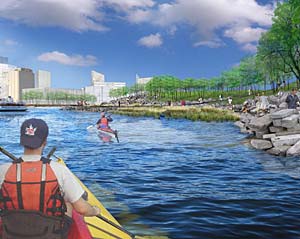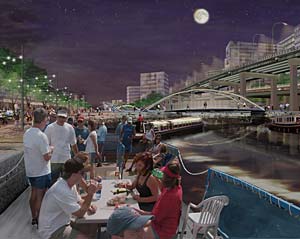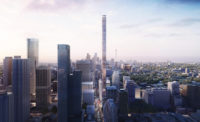Remaking the mouth of a river while carving a new neighborhood and parkland out of a post-industrial landscape is challenging enough. But the winners of the Lower Don Lands design competition in Toronto, Canada’s largest city, are also taking on a job with real symbolic weight: rejuvenating a 2,400-acre swath of polluted lakefront land that was thought to be beyond repair.


The Toronto Waterfront Revitalization Corporation announced last week that a team led by Michael van Valkenburgh Associates won the competition. The team also includes Behnisch Architects, Greenberg Consultants, and Great Eastern Ecology. They bested a field of 29 entrants and three other finalist teams led by Stoss, Weiss/Manfredi, and Atelier GIROT.
The $144 million Lower Don Lands redevelopment addresses a complex set of environmental and urban challenges on a brownfield site at the foot of the Don River, one mile from the center of downtown Toronto. These include restoring the mouth of the river where it flows into Lake Ontario—this stretch had been channeled and redirected more than 100 years ago—and the redevelopment of port land nearby. Toronto’s central business district has been isolated from the lake for a century by railroads and an expressway.
The Van Valkenburgh team won with a scheme that creates a broad new estuary zone for the river but also preserves an existing shipping channel as a nexus for mid-rise and high-rise development to house 10,000 people. Additionally, the plan establishes a large new park at the west end of the site, closest to downtown.
The Don Lands competition, which was managed by a quasi-public development agency, forms the keystone in a broader strategy to rebuild Toronto’s central waterfront. Work is already progressing nearby on another mixed-use redevelopment based on a plan by Urban Design Associates. Van Valkenburgh also plays a role there, too, having won a competition in 2005 to design the 18-acre Don River Park.





Post a comment to this article
Report Abusive Comment